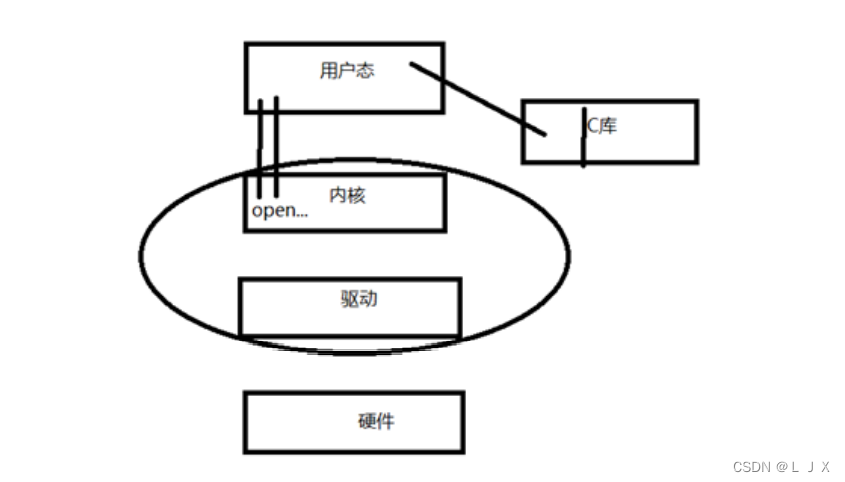目录
5.fopen,fread,fwrite,fseek,fclose函数
1.open—文件的创建与打开
函数原型
SYNOPSIS
#include <sys/types.h> //这里提供类型pid_t和size_t的定义
#include <sys/stat.h>
#include <fcntl.h>
int open(const char *pathname, int flags); /* 比较常用*/
int open(const char *pathname, int flags, mode_t mode);
int creat(const char *pathname, mode_t mode); //创建文件| Pathname | 文件的路径名,如果只写文件名,就默认当前目录,如果在文件名加上路径,就按照绝对路径来打开文件 |
| Flags | O_RDONLY 只读打开 O_WRONLY 只写打开 O_RDWR 可读可写打开 |
| mode | 一定是在flags中使用了O_CREAT标志,mode记录待创建的文件的访问权限 |
文件打开成功返回文件描述符,失败返回-1
在Flags参数中还可以加入以下参数
O_CREAT 若文件不存在则创建它。使用此选项时,需要同时说明第三个参数mode,用其说明该新文件的存取许可权限。
O_EXCL 如果同时指定了OCREAT,而文件已经存在,则出错。
O_APPEND 每次写时都加到文件的尾端。
O_TRUNC 属性去打开文件时,如果这个文件中本来是有内容的,而且为只读或只写成功打开,则将其长度截短为0。
Linux文件权限
Linux 系统中采用三位十进制数表示权限,如0755, 0644.
7 1+2+4
5 1+4
5 1+4
ABCD
·A- 0, 表示十进制
·B-用户
·C-组用户
·D-其他用户
‐‐‐ ‐> 0 (no excute , nowrite ,no read)
‐‐x ‐> 1 excute, (nowrite, no read)
‐w‐ ‐> 2 write
r‐‐ ‐> 4 read
‐wx ‐> 3 write, excute
r‐x ‐> 5 read, excute
rw‐ ‐> 6 read, write
read, write , excutedemo
#include <sys/types.h>
#include <sys/stat.h>
#include <fcntl.h>
#include <stdio.h>
int main()
{
int fd;
fd = open("./file",O_RDWR);
if(fd == -1){
printf("open file fail\n");
fd = open("./file",O_RDWR|O_CREAT,0600);
if(fd > 0){
printf("creat file success\n");
}
}
return 0;
}2.write—文件写入操作
函数原型
SYNOPSIS
#include <unistd.h>
ssize_t write(int fd, const void *buf, size_t count);| fd | 文件描述符 |
| *buf | 读入数据的首地址 |
| count | 写入数据个数 |
如果顺利write()会返回实际写入的字节数(len)。当有错误发生时则返回-1,错误代码存入errno中
文件关闭操作
SYNOPSIS
#include <unistd.h>
int close(int fd);功能就是简单的关闭文件,在每次写完之后都要调用close函数关闭文件
demo
#include <sys/types.h>
#include <sys/stat.h>
#include <fcntl.h>
#include <stdio.h>
#include <unistd.h>
#include <string.h>
int main()
{
int fd; //定义文件描述符
char *buf="liujiaxin"; //定义写入内容
fd = open("./file1", O_RDWR);
if(fd=-1){
printf("open file fail\n");
fd = open("./file1", O_RDWR|O_CREAT,0600);
if(fd>0){
printf("open file success\n");
}
}
printf("open fail success:%d/n",fd);
close(fd);
return 0;
}3.read—文件读取操作
函数原型
SYNOPSIS
#include <unistd.h>
ssize_t read(int fd, void *buf, size_t count);
| fd | 文件描述符 |
| *buf | 写入的数据的首地址 |
| count | 写入数据个数 |
成功返回读取的字节数,出错返回-1并设置errno,如果在调read之前已到达文件末尾,则这次read 返回0
在写入完内容后读取时要注意光标移动的问题,在写入完内容后光标移动到了内容的结尾,如果不把光标挪到内容开头的话是说明也读不到的。光标移动到开头有两种方式,关闭文件紧接着再打开或者就是调用lseek函数。
demo
#include <sys/types.h>
#include <sys/stat.h>
#include <fcntl.h>
#include <stdio.h>
#include <string.h>
#include <stdlib.h>
int main()
{
int fd;
fd = open("./file",O_RDWR);
char *buf = "sdad";
//打开文件
if(fd == -1){
printf("open file fail\n");
fd = open("./file",O_RDWR|O_CREAT,0600);
if(fd > 0){
printf("creat file success\n");
}
}
printf("open file success\n");
//写入内容
int n_write = write(fd,buf,strlen(buf));
if(n_write != -1){
printf("write success\n");
}close(fd);
open("./file",O_RDWR);//重新打开文件
//读取内容
char *BufRead;
BufRead = (char *)malloc(sizeof(char)*n_write+1);
int n_read = read(fd,BufRead,n_write);
printf("read %d bytes,context is %s\n",n_read,BufRead);
close(fd);
return 0;
}
4.lseek—文件光标移动操作
函数原型
SYNOPSIS
#include <sys/types.h>
#include <unistd.h>
off_t lseek(int fd, off_t offset, int whence);
| fd | 文件描述符 |
| offset | 对whence的偏移值 |
| whence | 偏移到的位置(Lniux系统种提供三个宏定义) 1.SEEK_SET 偏移到头 2.SEEK_END 偏移到尾 3.SEEK_CRU 偏移到当前位置 |
调用成功返回偏值,失败返回-1。
demo
#include <sys/types.h>
#include <sys/stat.h>
#include <fcntl.h>
#include <stdio.h>
#include <string.h>
#include <stdlib.h>
int main()
{
int fd;
fd = open("./file",O_RDWR);
char *buf = "sdad";
//打开文件
if(fd == -1){
printf("open file fail\n");
fd = open("./file",O_RDWR|O_CREAT,0600);
if(fd > 0){
printf("creat file success\n");
}
}
printf("open file success\n");
//写入内容
int n_write = write(fd,buf,strlen(buf));
if(n_write != -1){
printf("write success\n");
}
//使光标偏移到文件开头
lseek(fd,0,SEEK_SET);
//读取内容
char *BufRead;
BufRead = (char *)malloc(sizeof(char)*n_write+1);
int n_read = read(fd,BufRead,n_write);
printf("read %d bytes,context is %s\n",n_read,BufRead);
close(fd);
return 0;
}
5.fopen,fread,fwrite,fseek,fclose函数
fopen与open的区别
open是UNIX/LINUX系统调用的函数,返回的是文件描述符,它是文件在文件描述符里的索引。
fopen是标准C语言库中函数,在不同系统中应调用不同的内核api,返回值是应该指向文件结构的指针。
移植性
fopen是标准C语言库中函数,移植性更强;open属于UNIX/LINUX系统,移植性有限。

fopen 在用户态是缓存的,open 在用户态是没有缓存的。
fopen函数原型
FILE * fopen(constchar *path , cost char *mode)
/*
* @description : 打开一个文件
* @param ‐ path : 指定文件路径,如:"./test.txt"
* @param ‐ mode :指定文件的打开方式,如下图:
* @return : 成功,返回指向该文件的文件指针; 若失败,返回 NULL
*/参数说明:第一个参数为欲打开文件的文件路径及文件名,第二个参数表示对文件的打开方式
注:mode有以下值:
r:只读方式打开,文件必须存在
r+:可读写,文件必须存在
rb+:打开二进制文件,可以读写
rt+:打开文本文件,可读写
w:只写,文件存在则文件长度清0,文件不存在则建立该文件
w+:可读写,文件存在则文件长度清0,文件不存在则建立该文件
a:附加方式打开只写,不存在建立该文件,存在写入的数据加到文件尾,EOF符保留
a+:附加方式打开可读写,不存在建立该文件,存在写入的数据加到文件尾,EOF符不保留
wb:打开二进制文件,只写
wb+:打开或建立二进制文件,可读写 wt+:打开或建立文本文件,可读写
at+:打开文本文件,可读写,写的数据加在文本末尾
ab+:打开二进制文件,可读写,写的数据加在文件末尾fread函数原型
size_t fread(void*buff , size_t size, size_t count , FILE* stream)
/*参数说明:
第一个参数为接收数据的指针(buff),也即数据存储的地址
第二个参数为单个元素的大小,即由指针写入地址的数据大小,注意单位是字节
第三个参数为元素个数,即要读取的数据大小为size的元素个素
第四个参数为提供数据的文件指针,该指针指向文件内部数据
返回值:读取的总数据元素个数*/fread()作用:从fp所指向文件的当前位置开始,一次读入size个字节,重复count次,并将读入的数据存放到从buffer开始的内存中; buffer是存放读入数据的起始地址(即存放何处)。
fwrite函数原型
int fwrite(void*buffer,int size,int count,FILE*fp)
fwrite():从buffer开始,一次输出size个字节,重复count次,并将输出的数据存放到fp所指向的文件 中。buffer是要输出数据在内存中的起始地址(即从何处开始输出)。
fseek函数原型
int fseek(FILE *stream,long offset,int framewhere)
/*framewhere分别用3个宏:
SEEK_SET 既0 文件开头
SEEK_CUR 既1 文件当前位置
SEEK_END 既2 文件结尾*/参数:第一个为文件指针,第二个是指针的偏移量,第三个是指针偏移起始位置
返回值:重定位成功返回0,否则返回非零值
fclose函数原型
int fclose(FILE*stream)
/*
* @description :关闭一个已打开的流
* @param ‐ stream :文件指针(流)
* @return : 成功,返回0; 若失败,返回EOF
*/关闭一个文件流,使用fclose就可以把缓冲区内最后剩余的数据输出到磁盘文件中,并释放文件指针和有关 的缓冲区
demo
#include <stdio.h>
#include <string.h>
int main()
{
FILE *fp;
char *str = "liujiaxin";
char readBuf[128]={0};
fp= fopen("./liujiaxin.txt", "w+");
fwrite(str,sizeof(char),strlen(str),fp);
fseek(fp,0,SEEK_SET);
fread(readBuf,sizeof(char),strlen(str),fp);
printf("readdata:%s\n",readBuf);
return 0;
}






















 156
156











 被折叠的 条评论
为什么被折叠?
被折叠的 条评论
为什么被折叠?










